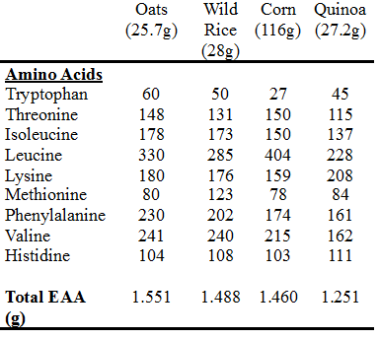In an earlier article I wrote about which grain is the best source for total protein, essential amino acids, branched chain amino acids (leucine, isoleucine and valine; BCAA) and arginine, from a list of grains that included oats, quinoa, corn, brown rice, potato, barley and millet (http://atomic-temporary-71218033.wpcomstaging.com/2014/07/30/which-grain-is-the-best-source-for-protein-essential-amino-acids-bcaa-and-arginine).
However, I have recently discovered that wild rice is also a high-protein containing grain, comparable to that of oats and better than quinoa. In this article I will compare total protein, essential amino acids, BCAA, arginine and glutathione precursor amino acid (glutamate, cysteine, glycine) content of wild rice to that of oats, quinoa and corn.
How does wild rice compare with oats, quinoa and corn in terms of total protein content (in grams, g) per 100 calories? First, it is important to mention that the serving size needed to yield 100 calories is shown in all tables: oats, 25.7g; wild rice, 28g; quinoa, 27.2g; corn, 116g. As shown in Table 1 below, oats are best, with 4.34g of protein per 100 calories. Although oats have more protein than wild rice, wild rice has more protein than both quinoa and corn (4.1g, wild rice; 3.84g, quinoa; corn, 3.79g)!
Table 1.
How do these grains rank in terms of total essential amino acid (EAA) content? As shown in Table 2, oats are best, with 1.551g of EAA per 100 calories. Second, and better than quinoa once again is wild rice, with 1.488g of EAA.
Table 2.
What about BCAA content, which is well known to stimulate protein synthesis (Blomstrand 2006)? As shown in Table 3, amazingly, corn contains more BCAA’s than any of the other grains, with 769 mg. Second are oats, with 749 mg, then wild rice at 698 mg, and finally, quinoa, with 527 mg. Once again, wild rice beats quinoa!
Table 3.
What about arginine content? Arginine is the precursor for the production of nitric oxide, which has been claimed to promote vasodilation in active muscle during exercise, thereby improving strength, power and recovery (Alvares et al. 2011). In terms of arginine content, wild rice is best, with 318 mg per 100 calories. Second are oats, with 306 mg. Third is quinoa with 297 mg, followed by corn, with 152 mg. Once again, a solid showing by wild rice!
What about amino acid content for glutamate, cysteine and glycine, the precursor amino acids for the formation of the antioxidant glutathione (GSH)? GSH is the most abundant antioxidant in our cells, and therefore, supplying its precursor amino acids will yield maximal GSH production (Sekhar et al. 2011). In Table 4 we see that oats contain the most combined glutamate, cysteine and glycine, with 1275 mg per 100 calories. But, once again beating quinoa is wild rice, with 955 mg. Corn (915 mg) and quinoa (751 mg) bring up the back of the list.
Table 4.
In sum, quinoa is well-popularized to be a protein-rich grain. However, in a previous analysis, oats were found to be better than quinoa in terms of total protein, EAA and BCAA content, and, arginine. Results from this analysis show that wild rice is also better than quinoa in each of these categories, and, has a higher amount of precursor amino acids needed for GSH synthesis.
So, go get some wild rice!
If you’re interested, please have a look at my book!
References
Álvares TS, Meirelles CM, Bhambhani YN, Paschoalin VM, Gomes PS. L-Arginine as a potential ergogenic aid in healthy subjects. Sports Med. 2011 Mar 1;41(3):233-48.
Blomstrand E, Eliasson J, Karlsson HK, Köhnke R. Branched-chain amino acids activate key enzymes in protein synthesis after physical exercise. J Nutr. 2006 Jan;136(1 Suppl):269S-73S.
Nutritional data provided by http://www.nal.usda.gov/fnic/foodcomp/search/
Sekhar RV, Patel SG, Guthikonda AP, Reid M, Balasubramanyam A, Taffet GE, Jahoor F. Deficient synthesis of glutathione underlies oxidative stress in aging and can be corrected by dietary cysteine and glycine supplementation. Am J Clin Nutr. 2011 Sep;94(3):847-53.



